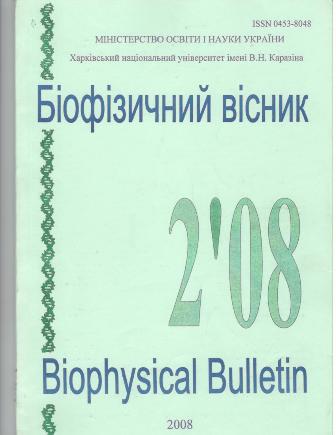Вплив гідрофобності органічних флуорофорів на ефективність безвипромінювального перенесення енергії електронного збудження в водно-міцелярних розчинах
Анотація
Методами оптичної спектроскопії досліджено вплив гідрофобності катіонних поліметинових барвників 3,3 '-діетілоксакарбоціанін йодид (DiOC2), 3,3'-діоктадецілоксакарбоціанін йодид (DiOC18) і 1,1'-діоктадеціл-3,3,3 ', 3'-тетраметіліндокарбоціанін перхлорат (DiI) на ефективність безвипромінювального перенесення енергії електронного збудження (FRET) між парами барвників DiOC18 / DiI і DiOC2 / DiI в нанооб'емі аніонних міцел додецилсульфату натрію (ДСН). Показано, що при зв'язуванні позитивно заряджених молекул барвника з негативно зарядженими мицеллами ПАР крім електростатичних взаємодій, ключову роль відіграють також гідрофобні взаємодії. Встановлено, що в водно-міцелярних розчинах, що містять барвники, що розрізняються гідрофобністю (DiOC2 і DiI), більш гідрофобний барвник (DiI), перешкоджає солюбілізації менш гідрофобного (DiOC2), і, як наслідок, ефективний FRET між парою барвників DiOC2 і DiI не спостерігається.
Завантаження
Посилання
2. S. W. Koch, Semiconductor Quantum Dots; World Scientific: Singapore (1993).
3. C. Szymanski, C.W. J. Hooper, M.A. Salazar etc., J. Phys.Chem. B 109 (2005) 8543-8546.
4. C.Wu, C. Szymanski, Z. Cain, and J.D. McNeill, J. Am. Chem. Soc. 129 (2007) 12904-12905.
5. Handbook of Fluorescent Probes and Research Products. Nine edition by R.P. Hauglang, Molecular
probes, New York (2002)
6. B.K. Thurmond, T. Kowalewski, K.L. Wolley, J. Am. Chem. Soc., 118 (1996) 7239 -7242.
7. J.Liu, Q. Zhang, E.E. Remsen, K.L. Wooley, Biomacromolecules, 2 (2001) 362-368.
8. Q. Zhang, E.E. Remsen, K.L. Wooley, J. Am. Chem. Soc., 122 (2000) 3642-3651.
9. A.A. Абрамзон, В.В. Бочаров. Поверхностно - активные вещества, Ленинград, Химия (1973).
10. С.Л. Ефимова, Ю.В. Малюкин, К. Кемнитц. Журн. прикл. спектр., 68 (2001) 569-572.
11. Yu.V. Malyukin, S.L. Efimova, K. Kemnitz. J. Lumin., 94-95 (2001) 239-242.
12. С.Л. Ефимова, А.В. Сорокин, А.Н. Лебеденко, Ю.В. Малюкин, Е.Н. Обухова. Журн. прикл.
спектр., 73 (2006) 152-157.
13. Дж. Лакович. Основы флуоресцентной спектроскопии, Москва, Мир (1986).
14. K. Shinoda, T. Nakagawa, H. Tamamushi, aned T. Isemura. Colloidal Surfactants, Some
Physicochemical Properties. New York and London (1963).
15. S. De, A. Girigoswami. J. Colloid Interface Sci. 271 (2004) 485-495.
16. K.A. Kozyra, J.R. Heldt, H.A. Diehl, J. Heldt. J. Photochem. Photobiol. A: Chem. 152 (2002) 199 –
2005.
17. S.A. Azim, R. Ghazy, M. Shaheen, F. El-Mekawey. J. Photochem. Photobiol. A: Chem. 133 (2000) 185
- 191.
18. Th. Förster. Ann. Phys. 2 (1948) 55 – 75.
19. В.Л. Левшин, Л.В. Левшин. Люминесценция и ее применение, Москва, Наука (1972).
20. B.L. Van Duuren, Chem. Rev. 63 (1963) 325 – 354.
21. E.A.G. Aniansson, S.N. Wall, M. Almgren, H. Hoffmann, I. Kielmann, W. Ulbricht, R.Zana, J. Lang
and C. Tondre. J. Phys. Chem. 80 (1976) 905-922.
22. F. Gao. Dyes and Pigments 52 (2002) 223-230.
23. A.Mishra, R.K. Behera, P.K. Behera, B.K. Mishra, G.B. Behera. Chem. Rev. 100 (2000) 1973-2011.
Автори, які публікуються у цьому журналі, погоджуються з наступними умовами:
- Автори залишають за собою право на авторство своєї роботи та передають журналу право першої публікації цієї роботи на умовах ліцензії Creative Commons Attribution License, котра дозволяє іншим особам вільно розповсюджувати опубліковану роботу з обов'язковим посиланням на авторів оригінальної роботи та першу публікацію роботи у цьому журналі.
- Автори мають право укладати самостійні додаткові угоди щодо неексклюзивного розповсюдження роботи у тому вигляді, в якому вона була опублікована цим журналом (наприклад, розміщувати роботу в електронному сховищі установи або публікувати у складі монографії), за умови збереження посилання на першу публікацію роботи у цьому журналі.
- Політика журналу дозволяє і заохочує розміщення авторами в мережі Інтернет (наприклад, у сховищах установ або на особистих веб-сайтах) рукопису роботи, як до подання цього рукопису до редакції, так і під час його редакційного опрацювання, оскільки це сприяє виникненню продуктивної наукової дискусії та позитивно позначається на оперативності та динаміці цитування опублікованої роботи (див. The Effect of Open Access).





